Another fantastic StarCityGames Invitational has come and gone, and this one was definitely another great tournament. I’ve said it before and I’ll say it again, if you can go and you are qualified, you should go! If you’re close to qualifying for the event, you should make the effort to get the extra few points you need. This time around they ran some LCQ events, a nice opportunity to acquire some extra Open Series points which are useful even if you are qualified as there are spots at the Players’ Championships for players who are interested in grinding a LOT of points (see Chris VanMeter, for example).
The Invitational itself features a dual format, which is really nice too. These days I’m kind of “over” Standard, but I was still excited for the event because I knew I’d get to compete in a real Legacy event, which is a bit of a rarity for me. Of course, having a shot at winning and qualifying for the Players’ Championships is amazing as well.
The way the weekend played out for me, I think it makes sense to talk about Legacy first, so that’s what we’ll do.
In my last article, I made a claim about Elves being the worst “good deck” in the format, and I stand by that statement despite it having two successful weeks on the Open Series. As you’ll note, it did not do particularly well in either the Invitational or the Open this weekend. One of the best things about the Legacy community is how vocal everyone is, and while I do think I am right, I am thrilled you all came and told me why you thought I was wrong.
As a slight aside, I think the Legacy Open at the Invitational is usually the hardest possible Open. All of the players who came out for the Invitational are at least on the stronger end of the spectrum, relatively speaking. They won IQs, they Top 8’ed an open, they played enough – got enough experience – to qualify for the Invitational, or they’re a writer for this very website. Given that the main event is over for all but eight people by the time the Legacy Open is underway, the average competitor in that Legacy Open is going to be of a higher quality than the average competitor in a non-Invitational open.
Anyway, back to the event at hand. I had been playing Deathblade locally to some success and decided I wanted to play it in the Open. Luckily for me, Gerry Thompson put me in contact with Derrick Sheets who 11-0’d (quite the feat) the last Invitational, including the 3-0 in the Legacy T8, and I was able to glean quite a lot of useful information from him. I am fairly well versed in Stoneforge Mystic strategies, and while adding Deathrite Shaman changes things of course, the overall strategy remains remarkably similar. The main difference between the two decks is in fact not the Deathrite Shamans but rather the reliance on True-Name Nemesis. In other words, the main difference comes from trying to be aggressive rather than relying on grinding the opponent out with Jace. Knowing and recognizing that is of course important, but playing the games with that in mind is another thing altogether – and rather more difficult.
My Legacy rounds in the Invitational started off a bit bumpy; I lost Round One to Sneak and Show in a pretty classic fashion. I kept a fine six-card hand against an unknown opponent and lost on turn one when I was facing down a Griselbrand after getting Probed. I won the second game and lost the third when I got flooded after keeping an okay hand. I could have easily lost the same way with literally any deck in the format, but it always feels bad even though my opponent was incredibly nice and graceful in victory.
This was a pretty bad omen, as I feel that my Stoneblade (NOT Deathblade) list is quite favored against Sneak and Show ordinarily, so I was already feeling a little foolish… but this was only the beginning of the problems I would face. Over the next two rounds I beat Storm and Elves, and then I finally lost to Rest in Peace out of Miracles when my deck refused to cooperate. I was out of the running in the Invitational and not particularly looking forward to playing Standard, which, as I mentioned, I find a bit boring right now. Fast-forward to Sunday, I’ve lost the finals of the Standard Open and I am again playing the same Deathblade deck. In Round Two I faced Dredge, losing game one after getting one turn with just a Swamp and Deathrite Shaman in play. I was able to win the other two games with careful play and by drawing my sideboard cards, and I felt good now sitting at 2-0. Unfortunately, the rest of the day would not go very well. In the following round I faced off against Eric Rill’s 4-Color Delver, and it felt like an incredibly hard matchup. I often feel like the only decks that lose to Stifle/Wasteland are decks that are playing their own Wastelands (this isn’t exactly true, obviously) and this was no exception. In the third game I kept Karakas, Marsh Flats, Plow, Shaman, and some other cards. It was a great hand, but against an untapped blue dual on turn one, I couldn’t afford to get Stifled so I couldn’t play the Shaman on turn one. I plowed on turn two with Karakas but it got Dazed, and no matter what I chose to do with the fetchland I was up against it. I sacrificed it, got Stifled, and lost from there many turns later when his second Delver flipped.
Oh well.
Finally in round four I faced off against the new Grixis PainterTop or CounterStone or whatever you want to call it. Maybe Dack.dec? I made a pretty bad mistake in the second game and would honestly attribute it to sheer fatigue. I dropped afterwards knowing neither my heart nor my mind was in it even if 8-2 would have an outside shot at making it.
This was the list I played. Updated slightly from Derrick’s winning list:
Creatures (13)
Planeswalkers (4)
Lands (20)
Spells (21)

From the maindeck I changed:
Out:
In:
And from the sideboard:
Out:
In:
These are, on the surface, very small changes… however, they are potentially very high-impact ones. From the main I added a Karakas to help fight against the uptick in Sneak and Show decks that I anticipated in light of CVM and Todd Anderson succeeding with the deck over the last couple of weeks. I was not having any trouble beating Death and Taxes in the local events I played in to prepare, but Karakas is great there as well and getting a few points for free, so to speak, was definitely something I was interested in.
The sideboard changes were also simple. Derrick told me he felt Sword of Feast and Famine underperformed for him, and, as it happens, I know the card quite well. It’s slow even when Stoneforge Mystic fetches it up on turn two against the unfair decks. I like it in a more controlling strategy – when you have more countermagic and discard it’s easier to buy time to drain all of their resources – but this deck is spread a bit thinner and it’s not quite as comfortable in the control role as my normal Stoneforge Mystic deck is. Eventually I decided that Engineered Explosives was the way to go, but also considered Marsh Casualties and Ethersworn Canonist as cards that might help against Elves and provide some advantages (albeit minor) in other matchups. In the end, I was nervous about beating Elves with this deck. Derrick told me it was a hard matchup and I believe him. This deck doesn’t have any of the super-knockout cards (Humility, Supreme Verdict, etc) that I’m used to playing to beat Elves, and if he told me it was going to be a bad matchup… well, I wanted to try to be prepared for it.
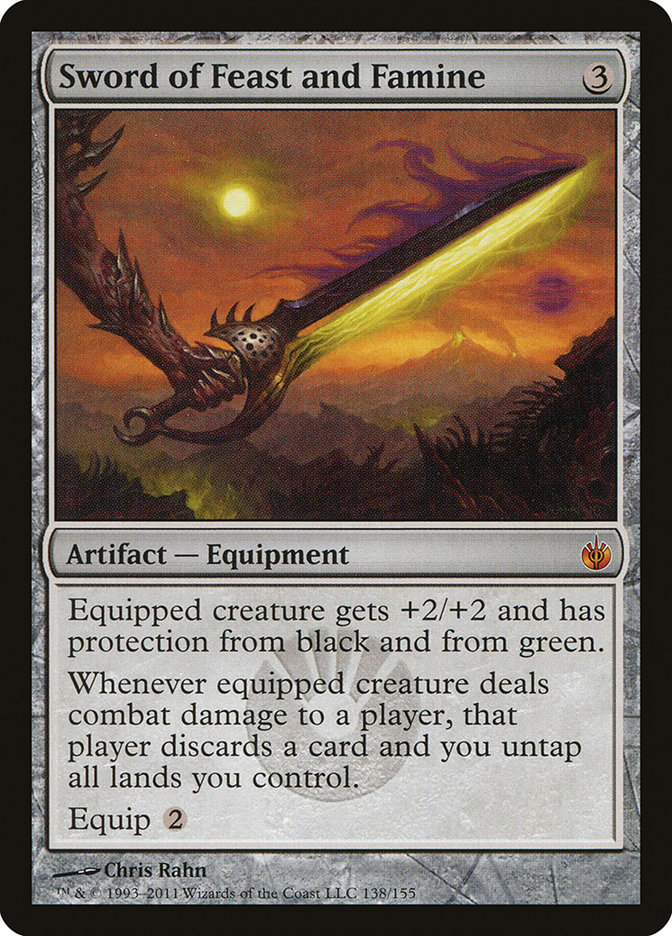
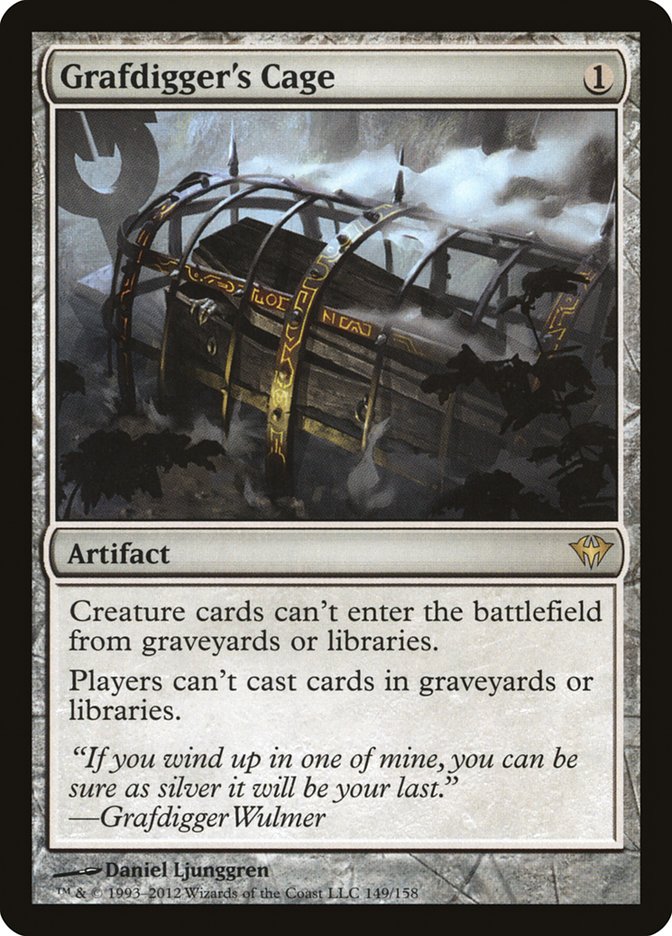
Replacing a Rest in Peace with a Grafdigger’s Cage was my idea, but Derrick was on board. Against graveyard decks it would have a slightly diminished though still devastating effect, but against Elves it would shine as it always does. Cage really forces them to play fair, which makes one-for-one countermagic and removal a fine strategy against them, and increases the effectiveness of your equipment. Killing their creatures with Umezawa’s Jitte is great… but if they’re going to Natural Order for a Progenitus or something on the following turn, it really doesn’t matter. Locking out their unfair engines is what you really need to do. A while back I either recommended or wanted to recommend Grafdigger’s Cage as a one-of auto-include in almost every sideboard that isn’t interested in abusing the graveyard, and I truly believe that to be a good idea for whenever Elves decides to crop up.
While it’s impossible to hate out a deck such as Esper Deathblade, if you’re interested in beating the strategy the best thing you can do is make the True-Name Nemesis part of the deck useless. I felt that most of my opponents had successfully done this in the eight matches I played in Columbus. Unfair decks laugh at True-Name Nemesis; it’s too slow and it can only attack or block, as I’ve been saying all along. It may be the best creature to ever wear an equipment… but when the equipment can only gain life or deal damage or kill creatures, that doesn’t really matter. Real control strategies such as Miracles don’t care about True-Name Nemesis either, really. Granted they are trying to interact on the normal axes, and while Swords to Plowshares and Karakas are not effective against True-Name Nemesis, Terminus certainly is. In addition, while Liliana of the Veil is fantastic against them, the rest of your cards are not that great. This combines for a somewhat bad Miracles matchup, in my experience. So, like I said, the metagame has seemingly turned “hateful.” The good news is that the Legacy format is almost boundless in size and there are plenty of decks I have yet to try out. I’m still excited to play Legacy and I hope you are too.
I’m out of Legacy matches and strategy to talk about. Before we move on, I just want to thank Derrick Sheets for his help in preparing, even if I didn’t win it was still very helpful to have tuning help from a player who is so knowledgeable about the deck.
Obviously if I lost my first match of Legacy at 2-2 to Sneak and Show that means I went 2-2 in the first Standard portion of the Invitational. Gerry Thompson, Joshua Cho and I had been brewing decks (although of course it was mostly Gerry doing the heavy lifting) leading up to the event, and while I played a lot of games going into the tournament I wasn’t too confident in anything. Gerry was wavering between black and green or maybe even blue devotion strategies, Cho was locked into B/g devotion and I was somewhere in between. The rest of my preparation led me to ultimately thinking the card Nightveil Specter was a nice card for the format. We anticipated Mono-Blue Devotion coming back around and knew it was an upgrade against red decks when compared to Lifebane Zombie. However, I didn’t want to cut the Lifebane Zombies – which meant we were going to have to do some serious cramming to fit everything together. I was already on this path with my States deck – agreeing to cut a Hero’s Downfall from the maindeck, something I had really not thought was ever even remotely a good idea.
Here’s the deck I played in the Invitational:
Creatures (17)
Lands (26)
Spells (17)
Sideboard

From the get-go, I was not entirely comfortable with this list. I made a lot of sacrifices to reach a list that I felt would provide equal opportunity to out-smart opponents in the mirror as well as providing a real chance at beating all the other decks in the format. Reid Duke asked me before the event started how I thought the popular decks would break down, and I told him black devotion, R/G and Jund Monsters, Supreme Verdict strategies and finally blue devotion would be what I expected. That’s a wide range to try to beat.
Nightveil Specter was supposed to be, in my mind, a good addition to try to beat that field. It’s great in the black mirror, almost always demanding an answer while making Gray Merchant all the better. Against Courser of Kruphix out of the Monsters decks the card is quite effective, essentially denying them cards almost at will when the game is going well. Of course, to beat Monsters things have to be going right already, but that’s a point for later. Against blue devotion Specter reigns supreme, able to block their small fliers and elemental tokens equally well. Of course, if Hall of Triumph is involved, things may get dicey. Finally, against Supreme Verdict strategies Nightveil Specter is a potential source of card advantage rather than just another durdly dude. Lifebane Zombie is a nice clock against them, but it is just a creature. The information is great, don’t get me wrong – and being unblockable to pressure planeswalkers is superb. However, Nightveil Specter can win the game left unchecked – drawing cards and using their own cards against them is one of the best feelings any deck can hope to provide in this Standard format.
Cutting an Underworld Connections might seem insane to you, but having a ton of three-drops is really troubling. Having a good mana curve is absolutely important, not only in Draft but in Constructed too. You need to play powerful things on-curve, and playing a three-drop every turn after the third isn’t going to cut it against everyone.
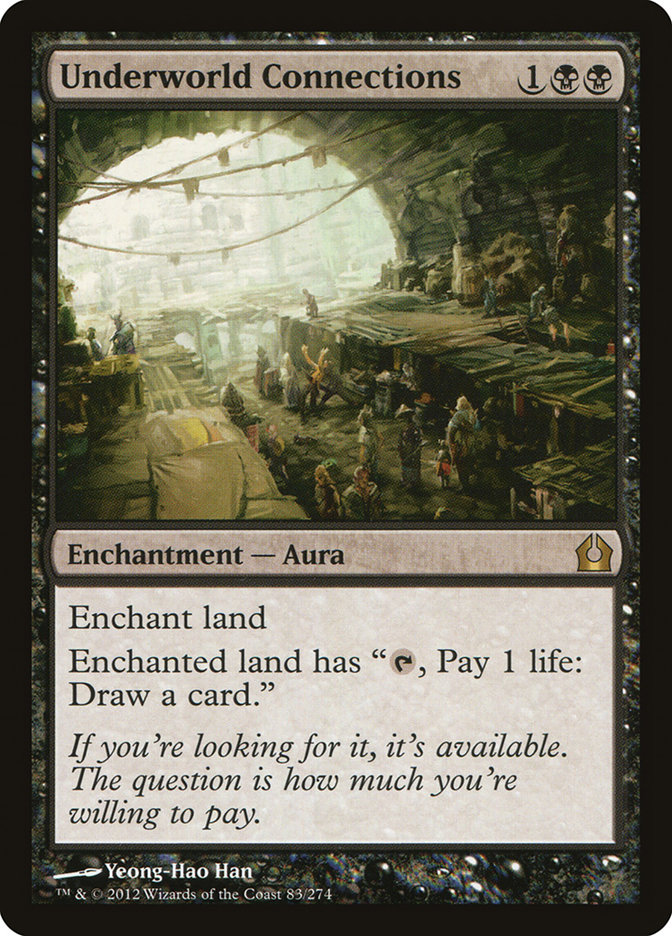
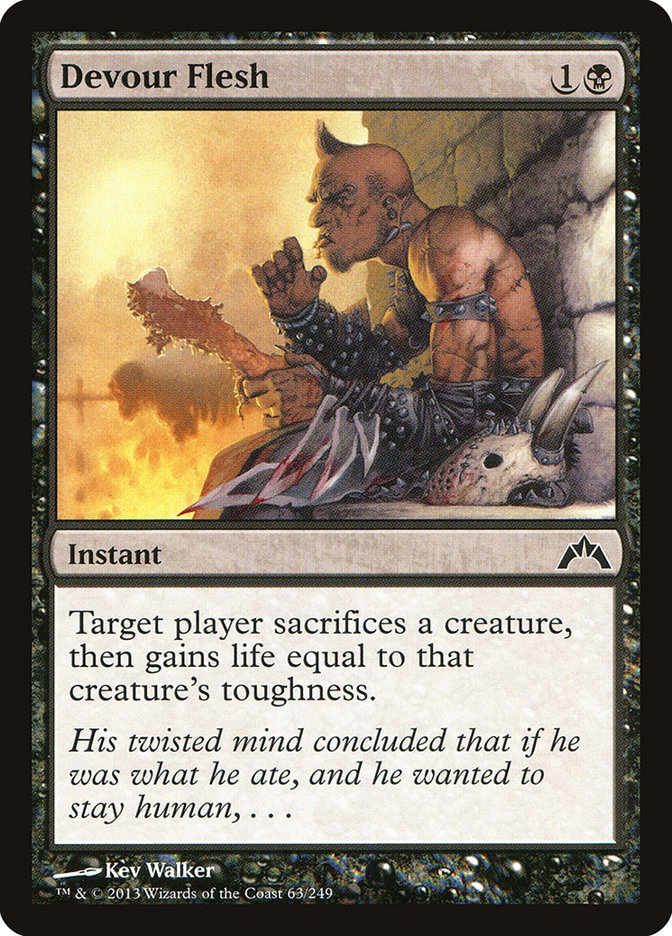
Not playing Devour Flesh was, in my mind, fine. I was anticipating green devotion and Jund Monsters to make up some part of the metagame, and the card doesn’t really shine against either. Ultimate Price is far stronger, being able to select your target and kill a mythic rare is a lot better than trading your card for an Elvish Mystic which has already provided them an advantage in the game. Of course, Ultimate Price is also great in the mirror – killing just about everything unless they have their own Specters.
The other changes were minor. Gerry had mentioned that he felt the deck feels good even when it’s slightly flooded but has a hard time winning if it misses a land drop, so adding a land made sense. Temple of Mystery over the Forest I played beforehand also makes sense – it’s a green source that can cast Nightveil Specter. Adding a Temple as the 26th land is also great, because in a long game – which this deck is especially well-suited to play for and win – drawing an extra Temple could very well be the difference between winning and losing.
I had originally wanted to play three Doom Blades and two Dark Betrayals in the sideboard, as well as Read the Bones for the mirror, but once we started talking about Nightveil Specter we had to make room for the other Lifebane Zombies (which are still great against many decks in the field), and adding in yet another three-drop – even Read the Bones – still didn’t make sense to me, so I went my own way with this list and somewhat failed. I beat the mirror, lost to Mono-Green Devotion, beat Jund Monsters and finally lost to Brave Naya when the third Fabled Hero combined with the topdecked Ajani’s Presence and his other two instants to deal me exactly lethal damage when I was at eighteen life. I think if I had untapped in that game I would have won, but if I had chump blocked that turn and then untapped my position would have crumbled quickly, so I feel like I played okay and had I drawn another removal spell earlier in the game I would have been better off. I could have also not killed his first creature (a Dryad Militant), but I could not have known how that game was going to play out and generally speaking not absorbing six damage from a Dryad Militant is probably the right move in most games in that matchup.
So it goes.
Luckily, the Invitational started on Friday. That meant on Saturday there was an entire Standard Open to play in if you’re no longer in the main event! For the Standard Open, I went back to a list that I was more familiar with:
Creatures (16)
Lands (25)
Spells (19)

For those of you who have read my articles in the past, this will look familiar to you, as it’s only a few cards off of my States list. The reasons I went with this list rather than the Invitational list are threefold:
One, I think it’s very important to like the deck you’re playing. The Invitational list felt wrong to me, it didn’t perform well but I also didn’t have faith in it or respect it. I may sound like a crazy person, but so be it. Two, Devour Flesh still seemed good to me. I could have easily put Devour Flesh in the other deck if I wanted to and ran it again at this event, but Nightveil Specter didn’t seem like it was a good fit for an Open metagame. I was expecting more green decks in general, and more burn decks. I wanted to be playing with Staff of the Death Magus, and while I didn’t get paired against a lot of burn decks – just one in thirteen rounds – I did see a fair bit of them, so I was glad to have it.
R/G Monsters, Small Naya, Big Naya, Black/White Midrange, Jund Monsters, and Esper Humans were the first seven decks I faced. None of the matches were particularly remarkable, though some were close and others were closer than I’d have liked. I felt fortunate to escape unscathed and knew that if I could win my eighth round I’d be in pretty good shape to make Top 8… or so I thought. Round eight I played against the mirror matchup, including the green splash, and we traded wins in the first two games. I was able to capitalize on an error he made in the third game to clinch the victory. I was pleased.
Unfortunately, due to the size of the field and the amount of rounds they chose to run at this particular event, 8-0-2 was not assured a spot in the Top 8 so I could not draw. I say “chose to run” because apparently there is no hard cap for adding the eleventh round; though the average number that is apparently used is 743, it is at the Head Judge’s discretion. Our field was 705, which is pretty close to 743. In other words, 8-1-1 wasn’t a lock. Neither was 8-0-2. 27 was the magic number of points we’d need to advance. Furthermore, I was paired down in round nine, so my opponent could not draw either.
I played against Red/Black Aggro in round nine, the first of these aggro decks I would face in the event. I lost game three when I kept a fine hand but failed to draw enough cheap removal spells to keep up; he also drew his Hammer of Purphoros (or one of several) which was basically a nightmare. The entire time we were playing sideboarded games, I was just hoping to draw Golgari Charms – but unfortunately I never did. Heading into round ten, I knew that if I faced off against another aggro deck I’d really need to draw Golgari Charm to have a chance.
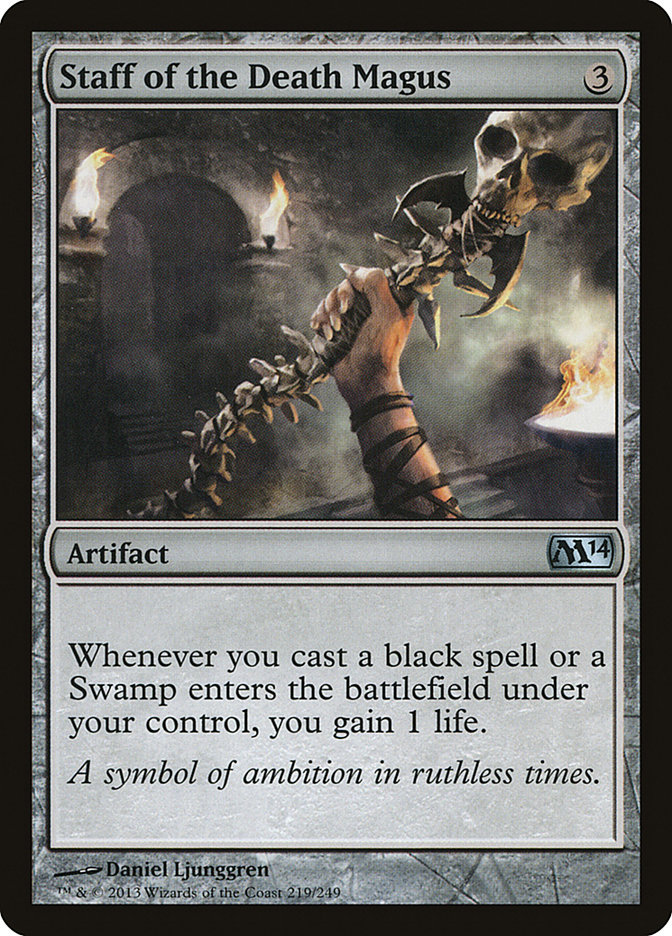 In round ten I was paired against a nice gentleman playing in his first Constructed tournament. He was making quite a run of things, playing burn. I on the other hand was excited to get to use my stupid Staffs of the Death Magus to their full effectiveness. Between this event and States earlier this year I’ve played 24 matches with this deck with Staff in the board and I got to use them exactly once. My opponent unfortunately got stuck on three lands and then got stuck on three spells in two consecutive games, and for my part I did get to play a Staff in the second game to clinch it.
In round ten I was paired against a nice gentleman playing in his first Constructed tournament. He was making quite a run of things, playing burn. I on the other hand was excited to get to use my stupid Staffs of the Death Magus to their full effectiveness. Between this event and States earlier this year I’ve played 24 matches with this deck with Staff in the board and I got to use them exactly once. My opponent unfortunately got stuck on three lands and then got stuck on three spells in two consecutive games, and for my part I did get to play a Staff in the second game to clinch it.
The next round was the quarterfinals and my opponent was playing mono-black aggro. This time we had decklists to look at, and at dinner Owen told me he thought Lifebane was fine since it could trade and Underworld Connections was bad because of how slow it was, and self-damaging, etc etc. He advised me to board in Vraska, Primeval Bounty and the two Charms, so that’s what I did.
Ultimately, it worked. Game three on the draw I mulligan into a great hand of two land, Decay, Charm, something. His start of Tormented Hero into Spiteful Returned played right into my first Charm, and drawing the second one was amazing as it let me kill a Master of the Feast that he followed up his initial onslaught with. I got Primeval Bounty into play while he puttered out, and from there I cast two Gray Merchants to drain first for two and then for four as well as creating a pair of 3/3 Beasts that more-or-less trumped his entire deck. I was fortunate to draw my sideboard cards, admittedly, but I felt good about winning a hard matchup.
The Top 4 was another match against a Mono-Black Devotion deck, this time I was miles ahead because I had the green splash and he didn’t. In reality the term “miles ahead” doesn’t really apply to having an edge in the mirror, but when both players have normal draws and one person is not instantly dead to Pack Rat or mulligans, having the green is great as I’ve said all along. The “cost” in tapped lands is not really notable in my opinion. It’s quite easy to configure this deck to beat ONE of the aggro decks, or the burn deck, as well as maintaining its advantage in the mirror and against control, even with the extra tapped lands. No deck can really do more than that, so again, I still like this deck. This match was covered briefly on camera for the third game and it was featured in text as well, but I still think it’s worth talking about.
Game One was interesting in that he flooded out a bit while I got stuck on four lands, then on three lands after he killed my Mutavault. This let my Lifebane Zombie and my plethora of removal spells actually damage him down to seven, four, and then one – then dead. Normally Lifebane Zombie is junk in this matchup, trading for absolutely anything, but I was pleased to have such a fast clock in a single card – he killed my initial Zombie and I think I drew all four of them this game, so I always had a backup one to deploy. Even drawing Pack Rat wouldn’t have been as good since my mana was so constrained. I lost the second game to Whip of Erebos and three Gray Merchants. I was digging hard for a way to remove the Whip with just three ways in the deck at that point, but I never found one. I think I was too far behind before the actual death-knell, but on the turn before I think I was still live to win the game if I found a Charm or Vraska. In the last game I took a mulligan on the play but had multiple lucky draws. The first was a Pack Rat on turn two after getting Thoughtseized. The second was two turns later, drawing a second Underworld Connections as soon as my first one got Thoughtseized. The second Connections drew me into two more lands which let me establish first an Erebos advantage and then a Gray Merchant advantage. Erebos connected for five damage in this game, which essentially sealed it for me.
In the finals I played against Mono-Red Aggro, which doesn’t seem beatable given the 75 I was playing. Of course, with four Merchants in my deck and 61 cards in his, if he had to mulligan twice I could probably steal a game and then who knows, maybe I could win game three on the play if my draw was great. That isn’t what happened though. I drew four Pack Rats in the first game and it was not remotely close, and in the second game I kept a Temple of Malady along with several two-drop removal spells and scryed a Gray Merchant away (which is somewhat awful to do, but obviously necessary) and found that second land much too late. The commentators got it right when they said Staff of the Death Magus isn’t ideal against this type of strategy, it isn’t really good against aggressive creatures (i.e. renewable sources of damage) even if they are aggro. Going forward it would make sense to reconfigure the sideboard.
Pharika’s Cure and Drown in Sorrow seem to be the most effective specialized sideboard cards against a deck like this. Shrivel is a bit narrower, killing fewer creatures but doing it faster. Doom Blade, of course, is great – but again, spending two mana and a card to trade with one of their guys is never going to get you ahead in these games, and while all you’re trying to do is stabilize and play a long game, you really do need a “sweeper” to accomplish that. Owen had jammed all four Doom Blades in his sideboard to really punish the Monsters players in the field. I scraped by without them, and I really think putting two copies of Pharika’s Cure in the board makes the most sense at this point.
I think the Staff of the Death Maguses should come out of the sideboard. Having two Pharika’s Cures would go a pretty long way in that matchup, and alternatively keeping in the Thoughtseizes and boarding in the Duresses, waiting to play your Demon until you know the path is clear from Chained to the Rocks, and waiting to play your Pack Rat until you know the path is clear from Searing Blood is a good way to win the match. The games can be scary and tight to navigate, but in reality the matchup is winnable without the Staffs and I’m looking forward to retiring them.
If I was going to play in a tournament tomorrow, I would expect an upswing in creature-based red aggro as well as Mono-Blue Devotion decks, which would prompt me to configure my sideboard like this:
2 Pharika’s Cure
1 Drown in Sorrow
1 Primeval Bounty
1 Dark Betrayal
2 Doom Blade
2 Golgari Charm
2 Erebos, God of the Dead
1 Vraska the Unseen
3 Duress
I’d be comfortable trying to win with this, and if it didn’t work in testing I’d change one or both Cures to Drown in Sorrows. If the Monsters decks die down in popularity, the Vraska could change into another Golgari Charm as well, but I do like the rest of the cards I’ve been playing with quite a bit. Golgari Charm does a really nice Shrivel impersonation, too, which I really appreciate. However, as always, from week to week the metagame will shift. I anticipate both red and blue aggro decks to be at the top tables this weekend at Grand Prix Chicago, and while black is obviously still a strong choice, it needs to be aware of the decks it’s trying to beat. If blue devotion takes the title at #SCGVEGAS, I would expect a resurgence of Supreme Verdict decks in time for the open in Portland (see you there!) and you can expect me to be playing with black cards if that’s the case.
